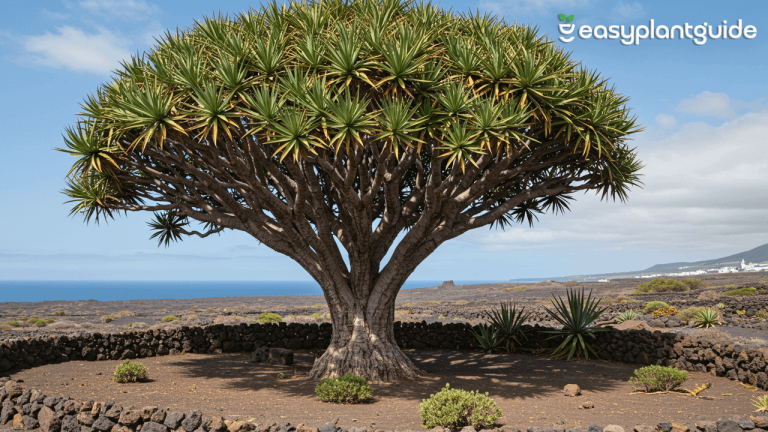Milk Cactus Plant: 5 Amazing Secrets for 2025
Have you ever brought home a plant that seemed to defy all the rules? You know, the kind that looks like it stepped right out of a Dr. Seuss book, all tall and architectural with those little ridges and tiny leaves? This plant is often called a “milk cactus plant ,” and it’s become one of the most popular houseplants of the past few years. But here’s the most mind-blowing secret about this plant: it’s not a cactus at all! This magnificent plant is actually a succulent, scientifically known as Euphorbia trigona.
It’s a member of the diverse Euphorbia family and is sometimes called the African Milk Tree. It’s a fantastic little case of mistaken identity, isn’t it? Understanding this single fact is your first step toward mastering its care and unlocking its full potential in your home. Let’s dive into the fascinating world of this extraordinary plant and uncover the secrets to helping it thrive in 2025 and beyond.

The African Milk Tree’s Incredible Story
Hailing from the warm, arid regions of Central Africa, the Euphorbia trigona has evolved some incredible tricks to survive. The most notable is the milky, latex-like sap that gives it its name. When a stem is broken, this white liquid oozes out. It’s the plant’s natural defense mechanism, protecting it from both thirsty animals and disease. This sap can be an irritant to human skin and eyes, so it’s always a good idea to handle your plant with care, perhaps while wearing gloves.
The plant’s distinct ridges serve a vital purpose, too. They allow it to expand and contract, cleverly storing water for long periods. Its upright, candelabra-like growth pattern is not only stunning but also a natural adaptation to its environment. It’s like a living skyscraper, reaching for the sky and demanding your attention with its unique, bold silhouette.
Why Euphorbia Trigona Isn’t a Real Cactus?
The milk cactus Plant may look like a cactus, but it’s actually a succulent from the Euphorbia family. Its nickname comes from its tall, ridged stems that resemble true cacti, yet it stores water in a different way. Unlike cacti, it produces a milky latex sap that defends it from pests and predators. This mistaken identity often leads to confusion in care, but knowing the truth helps you provide the right conditions and ensures the plant thrives beautifully.
Why This Plant is Taking Over Our Homes
The milk cactus Plant has gained popularity for blending modern style with simple care. Its bold geometric shape and rich green color make it a striking statement piece that instantly enhances any space, from sleek apartments to cozy living rooms. Unlike many plants, it’s incredibly forgiving and low-maintenance, yet it grows quickly, giving plant lovers the joy of watching it thrive with little effort.
Beyond its stylish appeal, the milk cactus Plant brings real benefits to your home. It helps purify the air by removing toxins, creating a cleaner and fresher environment. Its sculptural look not only transforms dull corners into vibrant focal points but also sparks conversations with guests. Whether you’re new to plants or an experienced collector, this cactus offers both beauty and ease, making it a standout choice for any home.
The 5 Big Secrets to Milk Cactus Plant Success
Unlocking your plant’s full potential is all about understanding its core needs. Think of these as the five big secrets that will turn you into a true Euphorbia trigona whisperer. We’re going to cover everything from its lighting needs to the best way to water it, ensuring your plant flourishes in 2025.
1. Light is a Dance, Not a Stare
The milk cactus Plant thrives in bright, indirect light but struggles under harsh, direct sun, which can cause permanent scorch marks. For best results, place it near east-facing windows for gentle morning light or a few feet away from south or west-facing windows. Using sheer curtains helps diffuse intense rays while keeping the brightness it loves. Rotate the plant weekly so all sides grow evenly, and watch for stretching—if it leans toward the light, it needs a brighter spot.
2. The Golden Rule of Watering
One of the biggest mistakes with milk cactus Plant care is overwatering, which leads to deadly root rot. This plant’s roots are built for drought, not constant moisture, so the golden rule is to let the soil dry out completely before watering again. Use the finger test—if it’s damp two inches down, wait. When watering, soak the soil thoroughly and let excess water drain. Empty the tray, reduce watering in winter, and consider using a moisture meter for accuracy.
3. The Perfect Potion of Soil and Pot
A plant’s home is just as important as the care it receives. The right pot and soil can make all the difference. The milk cactus Plant needs a soil mix that drains quickly, so its roots never get soggy. A good mix prevents that one big mistake we just talked about.
4. Pruning is a Form of Art
Pruning your milk cactus Plant isn’t harmful—it’s essential for shaping and encouraging fuller growth. With a clean pair of sharp shears, you can remove damaged limbs, control its size, or create a more balanced, sculptural look. Always wear gloves, since the milky sap can irritate skin. Cut branches at joints to spark new growth or trim the main stem’s top to promote branching. Allow cut ends to dry and callus before propagating for healthy new plants.
5. Listening to Your Plant’s Signals
Your milk cactus Plantcommunicates through clear signs, and learning to read them makes care much easier. A mushy, soft stem is a serious warning of overwatering and root rot. Wrinkling or drooping means the plant is thirsty and using up stored water. Red or brown spots signal sunburn from too much direct light, while leggy, stretched growth shows it needs a brighter spot. Yellowing or dropping lower leaves can be normal, but rapid loss often indicates stress.
How to Care for Cactus Milk Plant
1. Light Requirements
The Cactus Milk Plant (Euphorbia trigona) loves bright, indirect light and will thrive when placed near a window that receives plenty of sunshine. While it can tolerate some direct light, prolonged exposure to harsh afternoon sun can cause sunburn on its stems. If you’re growing it indoors, east or west-facing windows are ideal. In low-light conditions, the plant may grow tall and leggy, so always ensure it gets consistent brightness for healthy growth.
2. Watering Schedule
Watering the Milk Cactus Plant requires balance. This succulent prefers the soak-and-dry method, meaning you should water deeply and then allow the soil to dry out completely before watering again. Overwatering is one of the biggest dangers, as it can cause root rot and fungal issues. During summer, watering once every 10–14 days is usually enough, while in winter, reduce it to once a month. Always check the soil moisture with your finger before watering.
3. Soil and Potting
A well-draining soil mix is essential for the Cactus Milk Plant to remain healthy. Standard cactus or succulent potting soil works best, especially when mixed with perlite or sand to increase aeration. The plant should always be placed in a pot with drainage holes to prevent excess water from accumulating at the roots. Repotting every 2–3 years helps refresh the soil and provides more space for root expansion, which keeps your plant growing strong and vibrant.
4. Temperature and Care Tips
- Thrives in warm, dry conditions with ideal temperatures between 18–27°C.
- Must be kept away from cold drafts, air conditioners, and frost.
- Stems should be wiped occasionally with a soft, damp cloth to remove dust.
- Fertilize monthly in spring and summer using a diluted cactus fertilizer.
- With consistent care, the plant can stay healthy and flourish for many years.
Milk Cactus Plant Habitat and Care
| Element | Ideal Conditions | Why It Matters |
| Light | Bright, indirect sun | Prevents sunburn, encourages strong growth. |
| Watering | Deeply, when soil is fully dry | Avoids root rot and simulates natural conditions. |
| Soil | Cactus/succulent mix | Provides essential drainage and aeration. |
| Pot | Terracotta with drainage hole | Allows roots to breathe and wicks away moisture. |
| Fertilizer | Diluted, once a month (Spring/Summer) | Supports vigorous growth during its active season. |
| Temperature | 65-80°F (18-27°C) | Mimics its native African habitat for optimal health. |
Decor Ideas
The milk cactus Plant is more than just a plant—it’s a powerful design element that can transform any room. With its tall, sculptural shape, it makes the perfect focal point, especially when placed in a corner or near a window to draw the eye upward and create a sense of openness. A carefully chosen pot, whether minimalist ceramic or rustic terracotta, enhances its bold form. Even in smaller setups, placing it on a side table or stand instantly adds drama and sophistication, fitting seamlessly into modern, minimalist, or bohemian interiors.

It also shines when styled with other greenery, helping you create a lush, inviting atmosphere. Pairing a milk cactus Plant with trailing vines or round-leafed plants creates striking contrasts in shape and texture, turning a simple corner into a vibrant, green oasis. For compact spaces like desks, bookshelves, or apartments, a smaller milk cactus Plant is the perfect choice—it grows upward without spreading too wide, bringing nature and life into your home without adding clutter.
Best Styling Tips for Your Home
- Place a tall milk cactus Plant in a corner to create vertical drama
- Use a minimalist ceramic or terracotta pot for a modern touch
- Combine it with trailing plants for a lush green oasis
- Keep smaller ones on desks, shelves, or side tables
- Pair with natural textures like wood or stone for harmony
The Hidden Benefits of Milk Cactus Plant
Beyond being a stylish indoor plant, the milk cactus Plant also improves your living environment. It naturally purifies the air by filtering out toxins, leaving your space fresher and healthier. Its strong, upright growth pattern creates a calming, architectural presence that adds balance to your interior design. By thriving with minimal care, it reduces stress and gives plant owners a sense of accomplishment. This combination of beauty, resilience, and wellness benefits makes it an unbeatable addition to modern homes.
Common Mistakes to Avoid
- Overwatering, which leads to root rot and mushy stems
- Exposing it to harsh, direct afternoon sunlight
- Using pots without drainage holes
- Neglecting to rotate the plant for even growth
- Handling without gloves and risking skin irritation
Final Thoughts
The milk cactus Plant , or Euphorbia trigona, is truly a fascinating and beautiful plant. By unlocking these five secrets to its care, you’re not just keeping a plant alive; you’re helping it thrive and transform your living space. Remember to give it the right amount of light, be mindful of overwatering, choose the right soil and pot, and be a confident pruner.
Most importantly, learn to listen to what your plant is telling you. This unique succulent is one of the most rewarding additions you can make to your home in 2025. It’s a stunning reminder that with a little bit of knowledge and a lot of love, anyone can have a green thumb.
Want to explore more? Check out our guide on Large Leaf Plants Indoor







